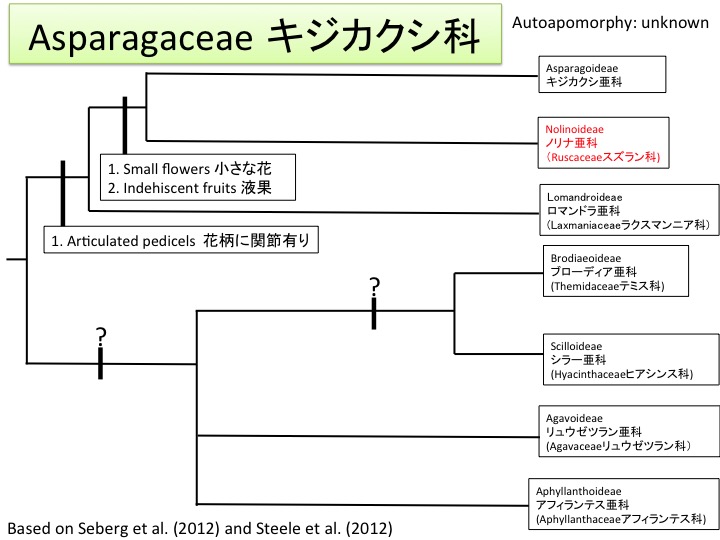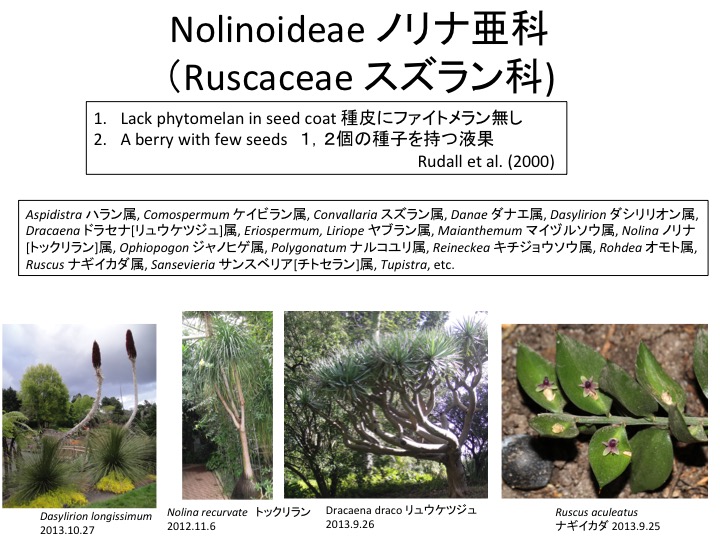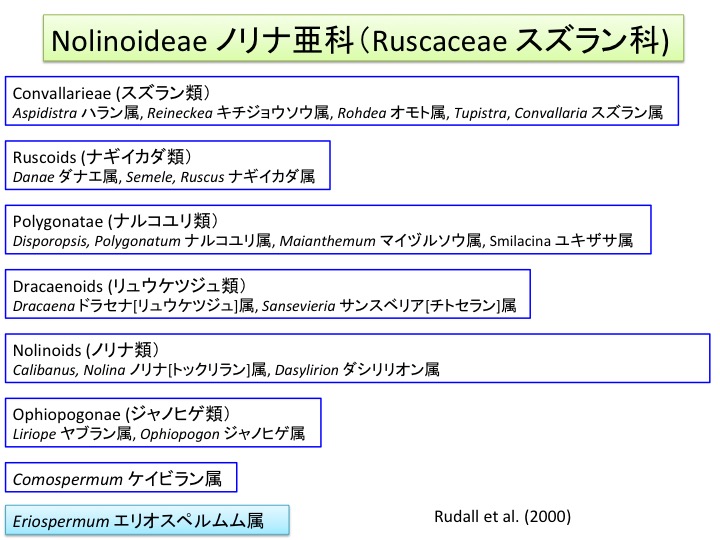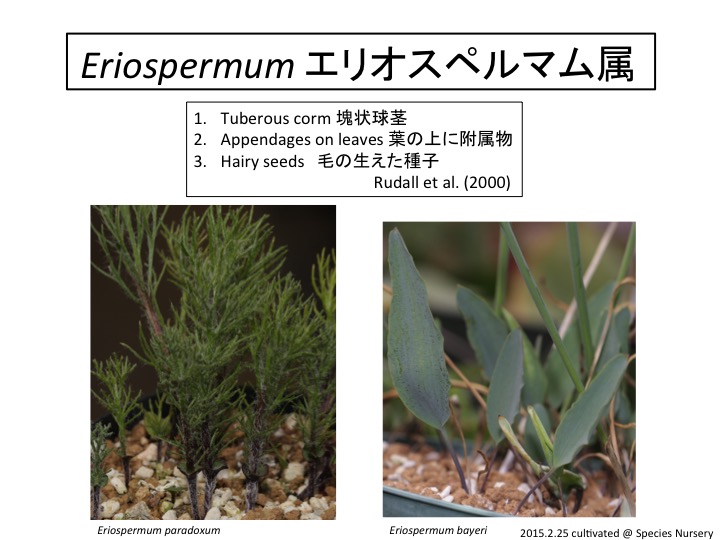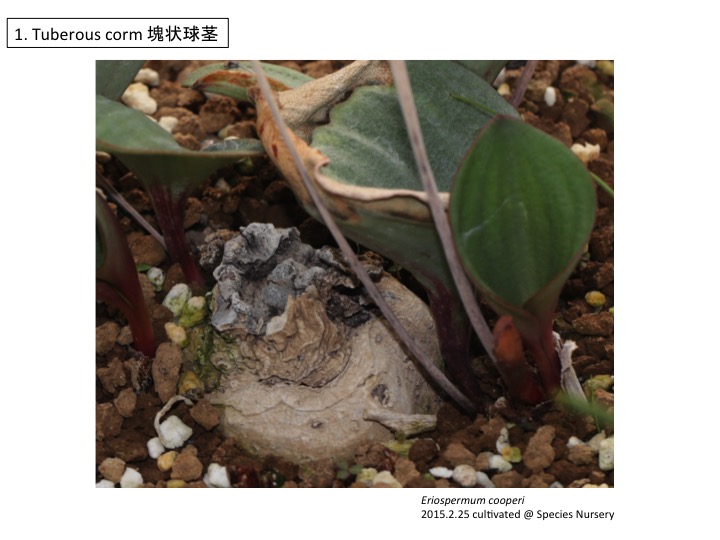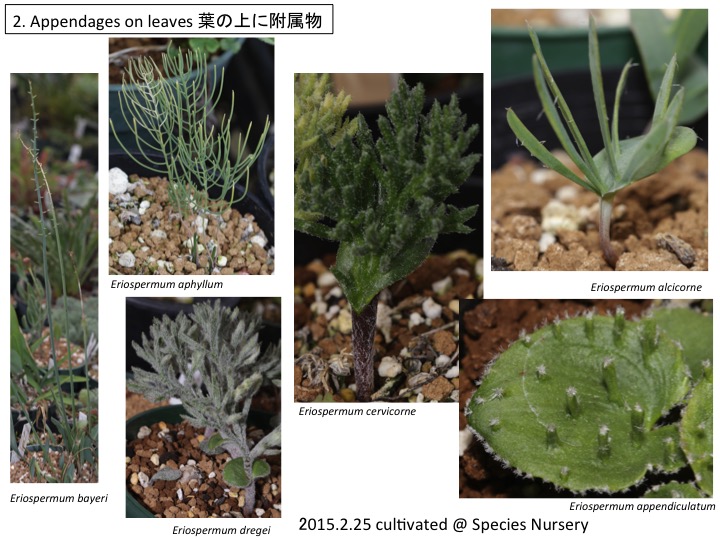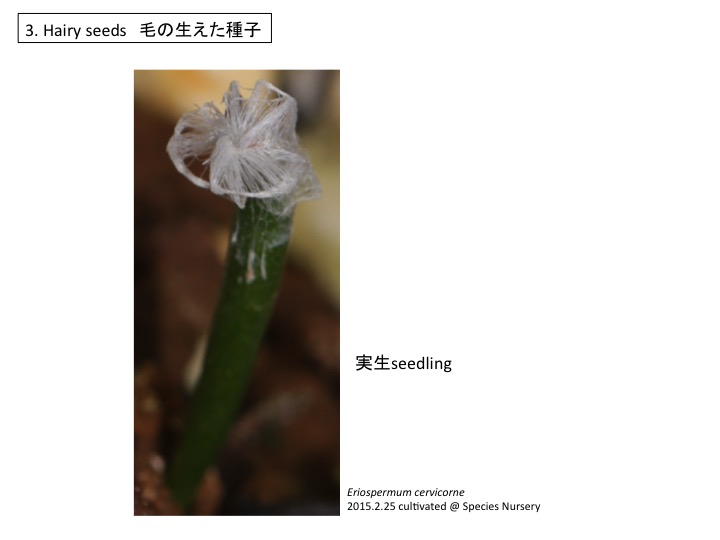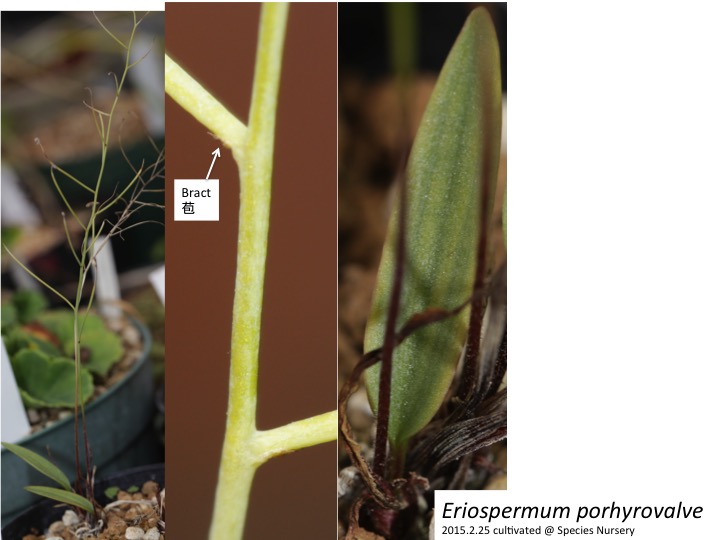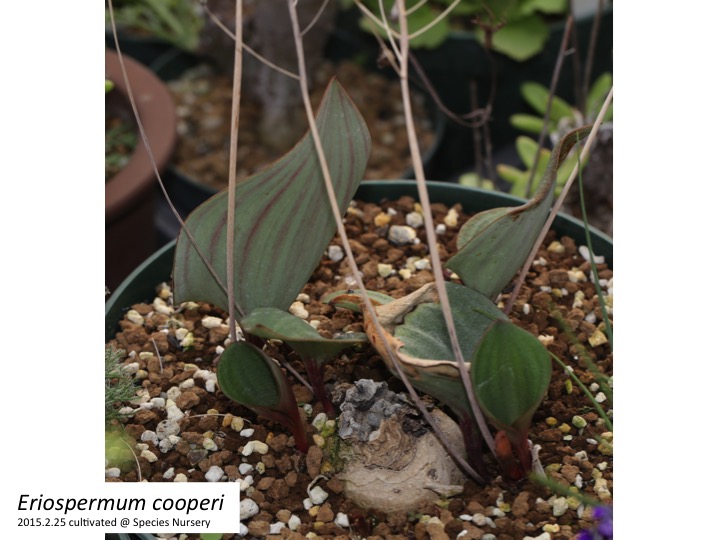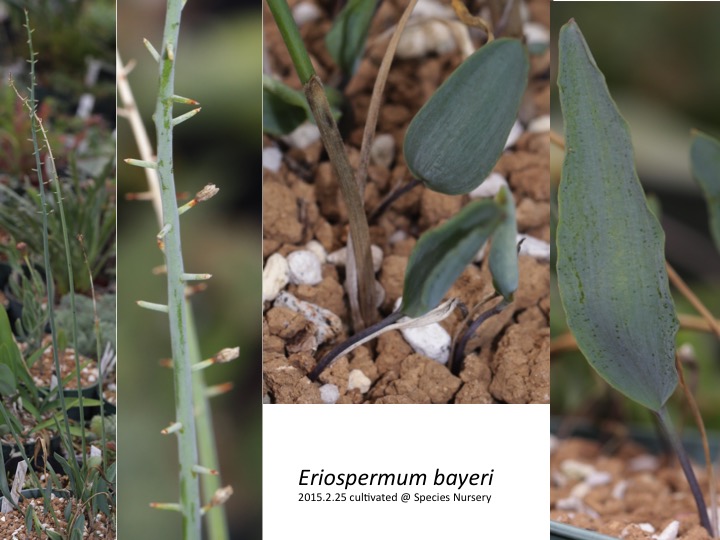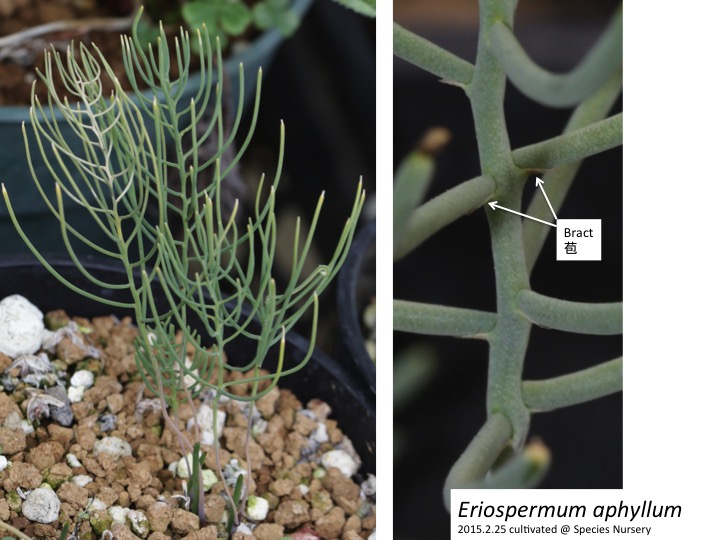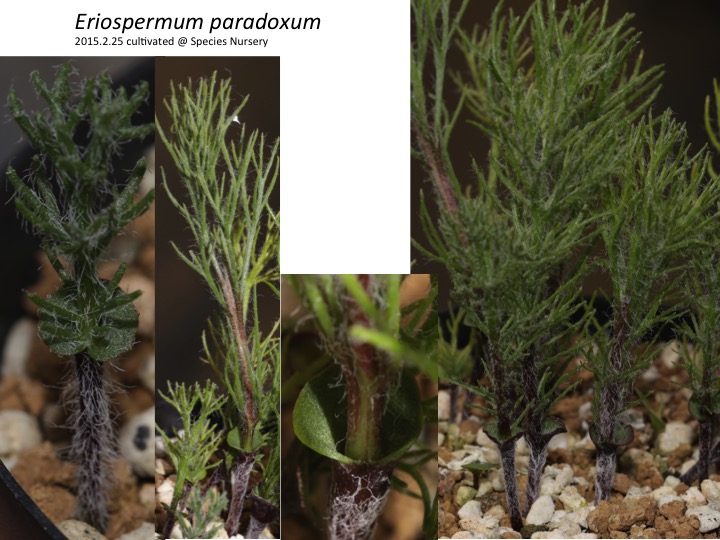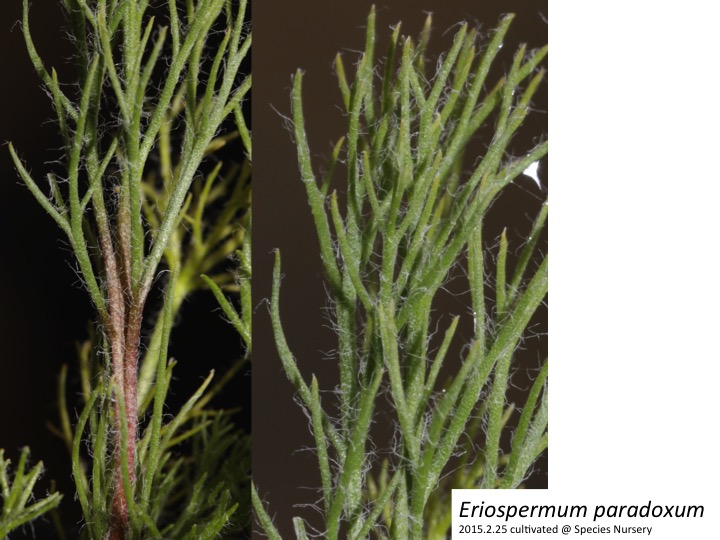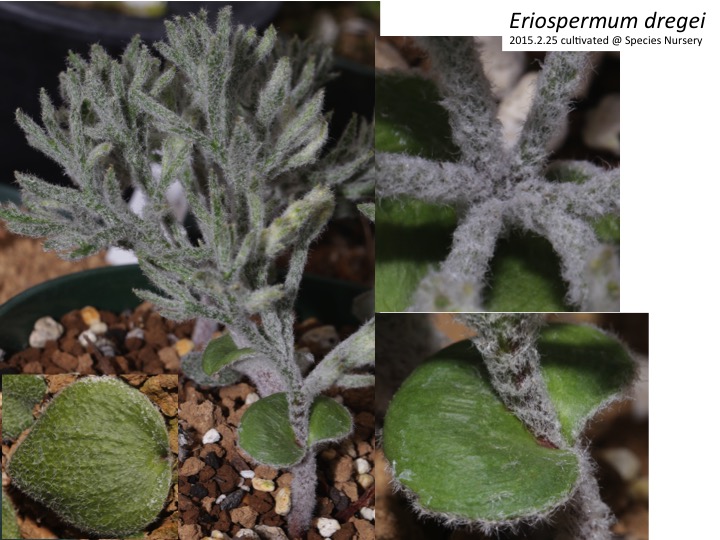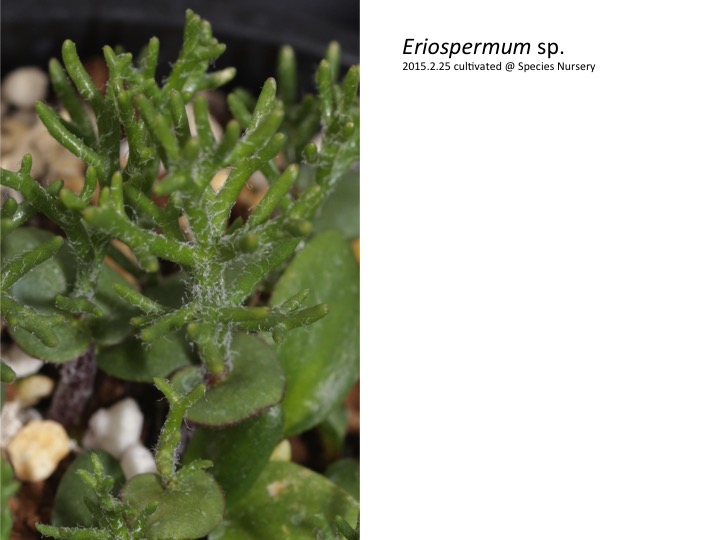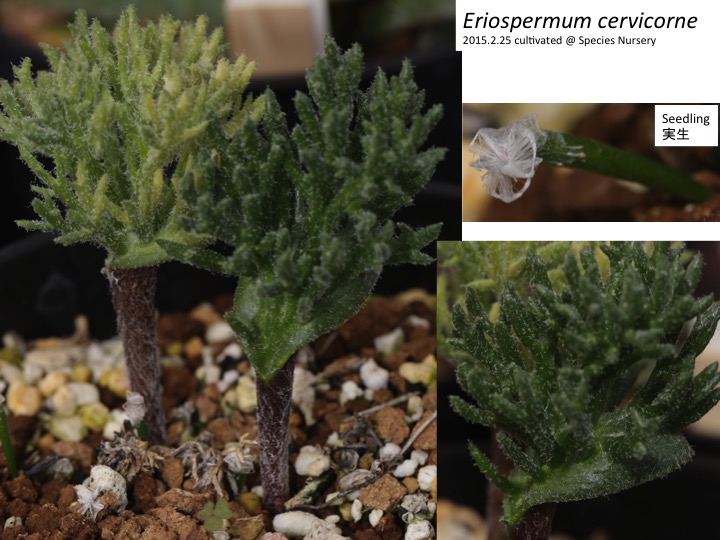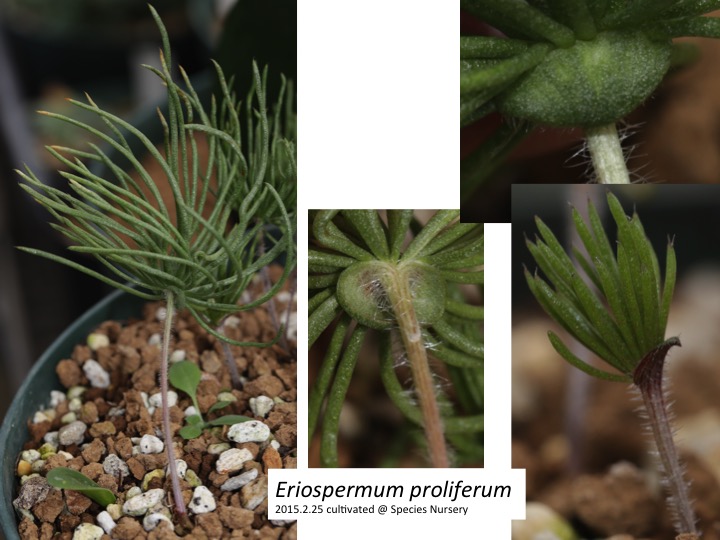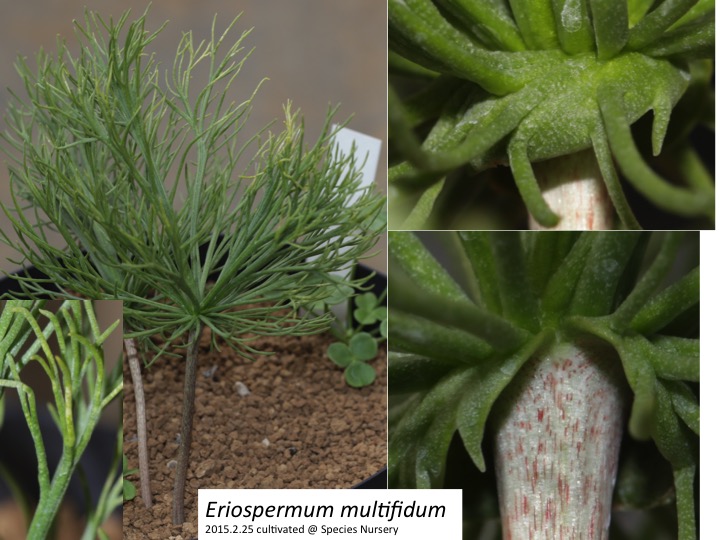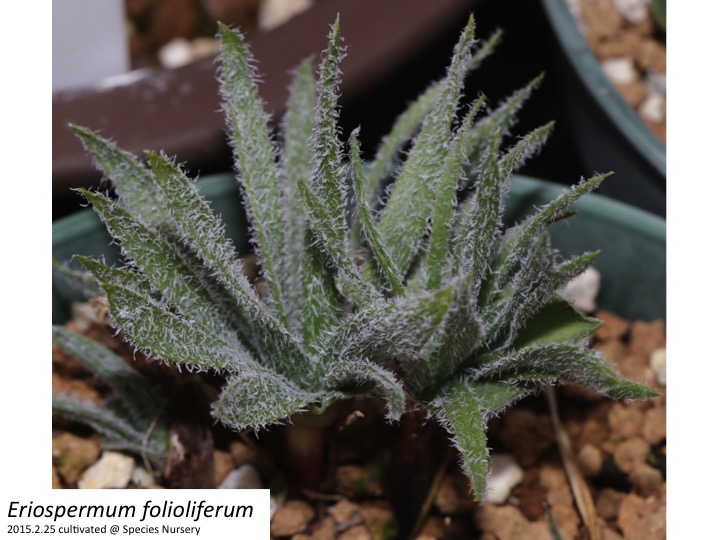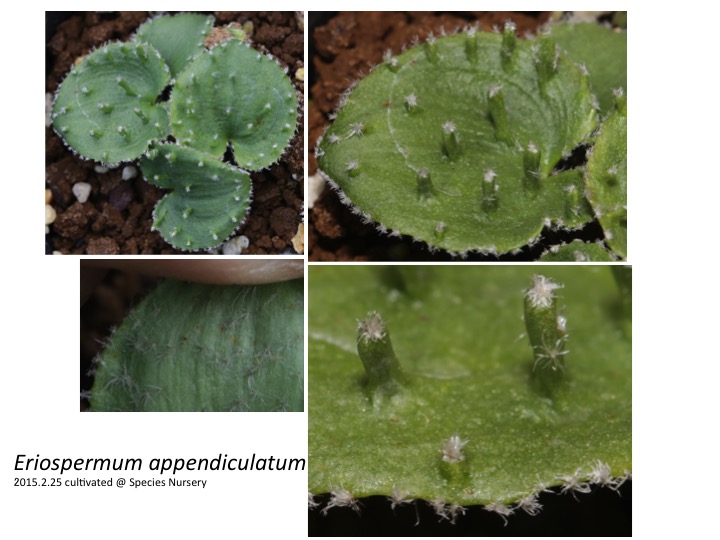Seberg, O., Petersen, G., Davis, J. I., Pires, J. C., Stevenson, D. W., Chase, M. W., Fay, M. F., Devey, D. S., Jørgensen, T., Sytsma, K. J., and Pillon, Y. 2012. Phylogeny of the Asparagales based on three plastid and two mitochondrial genes. American J. Bot. 99: 875-889.
Steele, P. R., Hertweck, K. L., Mayfield, D., McKain, M. R., Leebens-Mack, J., and Pires, J. C. 2012. Quality and quantity of data recovered from massively parallel sequencing: Examples in Asparagales and Poaceae. American J. Bot. 99: 330348.
キジカクシ亜科は3個以上の種子を含む液果を形成し、ファイトメランのある種子を形成する。
Asparagoideae form berries with more than three seeds with phytomelan..
Rudall, P.J., Conran, J.G., and Chase, M.W. 2000. Systematics of Ruscaceae/Convallariaceae: a combined morphological and molecular investigation. Bot. J. Linn. Soc. 134: 73-92.
Eriospermumの全ての写真はSpecies Nurseryの藤川史雄様のご厚意によって藤川様の栽培品を撮影させていただきました。また、学名や記載内容について同好の方からご教示いただきました。この場を借りて感謝申し上げます。
約100種が南アフリカを中心に分布している (Perry 1994)。このうち約13種は葉の向軸側に突起を形成する。突起を形成する種のほとんどは同じ核型を持つことから単系統群であろうと考えられている(Vosa and Perry 2012)。
All photos of Eriospermum are took in Species Nursery by great courtesy of Mr. Fumio Fujikawa. I also appreciate an anonymous reader for suggestion on some scientific names.
Approximately 100 species are distributed mainly in South Africa (Perry 1994). About 13 species form leaf appendages but others do not (Perry 1984). These appendaged species share similar karyotype and are inferred to be monophyletic (Vosa and Perry 2012).
Perry, P. L. 1994. A revision of the genus Eriosperma (Eriospermaceae). Contrib. Bolus Herb. 17: 1-320.
Vosa, C.G. and Perry, P.L. 2012. On the cytotaxonomy of the genus Eriospermum Jacq. Ex Willd. (Erisspermaceae). Caryologia 52: 117-125.
Eriospermumの根茎は胚軸起源である(Perry 1994)。
The corm of Eriospermum is originated from a hypocotyl (Perry 1994).
Eriospermumの種には、変わった花序や突起のある葉を持つものがある。E. bayeriは花後も花序が長く残存し、光合成を行う。E. aphyllumは花を付けない栄養性花序様器官を持つ。光合成に役立っていると考えられる。E. dregeiは複雑に分岐して毛がたくさん生えた栄養性花序様器官を形成する。光合成とともに、霧がかかるような乾燥地帯に分布していることから、霧から水分を選る役割があるのかもしれない。E. cervicorneは葉の上に多数の突起がある。複雑に分岐した栄養性花序様器官が苞葉に癒合しているように見える。E. alcicorneやE. appendiculatumは葉の上に突起を形成する。これらの突起も、栄養性花序様器官が癒合してできたのかもしれない。発生過程や突起の維管束の道管と師管の位置関係を調べると、突起が花序起源かどうかわかるかもしれない。また、他の植物の花序形成に関わる遺伝子が発現しているか、発現しているならどう変わっているかも調べると面白そう。
注:ここでは平面葉以外の立体的なシュート的器官や葉状突起を、花序が変形してできた器官ではないかという仮説のもと「栄養性花序様器官」と呼んでいますが、本当に花序由来かはまだわかりません。今後の研究で明らかになっていくと思います。
Some species of Eriospermum has unusual inflorescence-like organs and leaf appendages. E. bayeri has long-lasting inflorescence after blooming. E. aphyllum forms non-reproductive inflorescence-like organ, which is formed without flowers and stout stems. E. dregei forms multiply divided vegetative inflorescence-like organ with dense hair. A leaf of E. cervicorne has appendages, which appear to be a fusion of multiply divided vegetative inflorescence-like organ. E. alcicome and E. appenduculatum has appendages on their leaves. These appendages may be homologous to branches of a vegetative inflorescence-like organ. Development and anatomical analyses of these appendages will give insight on the origin of leaf appendages in Eriospermum.
The unusual vegetative inflorescence-like organs and leaf appendages appear to be adaptive for dry environments to capture water from fogs.
The number and size of appendages are variable in a population of some species, but it appears that the total area of appendages and leaf is mostly constant between leaves (Perry 1994). This suggests that appendages are useful for photosynthesis.
Perry, P. L. 1994. A revision of the genus Eriosperma (Eriospermaceae). Contrib. Bolus Herb. 17: 1-320.
E. porhyrovalveの花序は花後枯れる。
Inflorescences of E. porhyrovalve is senesced when seeds are not harvested.
E. cooperiの花序は花後枯れる。
Inflorescences of E. cooperi is senesced when seeds are not harvested.
Eriospermum bayeriの花序は種子が稔らなくても残存し、光合成をしているようだ。
Inflorescences of Eriospermum bayeri is alive even after no fruits are formed.
Eriospermum aphyllumの花序様の器官は花を付けず、長く維持されることから、栄養性の花序かもしれない。トウダイグサ科の植物のように、葉でなく柱状の茎を持つことは、蒸散を防ぎ、乾燥環境に適応していると考えられる。
Eriospermum aphyllum forms a vegetative inflorescence-like organ, which does not have any flowers and is long-lasting. As some succulent species in Euphorbiaceae, the vegetative inflorescence-like organ should be adaptive under dry conditions.
Eriospermum paradoxumは複雑に分岐する栄養性花序様器官を形成する。枝分かれし、毛が生えた栄養性花序様器官は乾燥地域で、霧から水分をとるのに役立っていると考えられる。
Eriospermum paradoxum forms a multiply divided vegetative inflorescence-like organ. Hairy and branched vegetative inflorescence-like organs should be adaptive for dry conditions to capture water from fogs (Vogel and Müller-Doblies 2011).
Vogel, S. and Müller-Doblies, U. 2011. Desert geophytes under dew and fog: The “curly-whirlies” of Namaqualand (South Africa). Flora 206: 3-31.
やや不規則な総状花序のような分岐の栄養性花序様器官を形成する。
Partly disarranged raceme-like vegetative inflorescence-like organs.
複雑に分岐し毛が生えた栄養性花序様器官。栄養性花序様器官を形成しない葉は両面に毛が生えているが、栄養性花序様器官を抱く葉(苞)は向軸側に毛が無い。どうしてなのだろうか。
Complex, branched and hairy vegetative inflorescence-organs. A leaf is hairy on both sides but the adaxial surface of a bract is relatively glabrous. Why?
複雑に分岐し毛が生えた栄養性花序様器官。複雑な分岐で、どんな発生的な規則でできているのか不明。
Complex, branched and hairy vegetative inflorescence-like organs. The pattern of branching is complicated and what is a developmental rule to organize the form..
分岐した栄養性花序様器官が苞に癒合しているように見える。
A vegetative inflorescence-like organ appears to be fused with a bract.
分岐した栄養性花序様器官が苞に癒合しているように見える。
A vegetative inflorescence-like organ appears to be fused with a bract.
分岐した栄養性花序様器官が苞に癒合しているように見える。
A vegetative inflorescence-like organ appears to be fused with a bract.
葉の上の突起は葉状。栄養性花序様器官が癒合し、枝が葉状化したのだろうか。
Appendages are leaf-like. After the fusion of a vegetative inflorescence-like organ, branches may be changed to be leaf-like.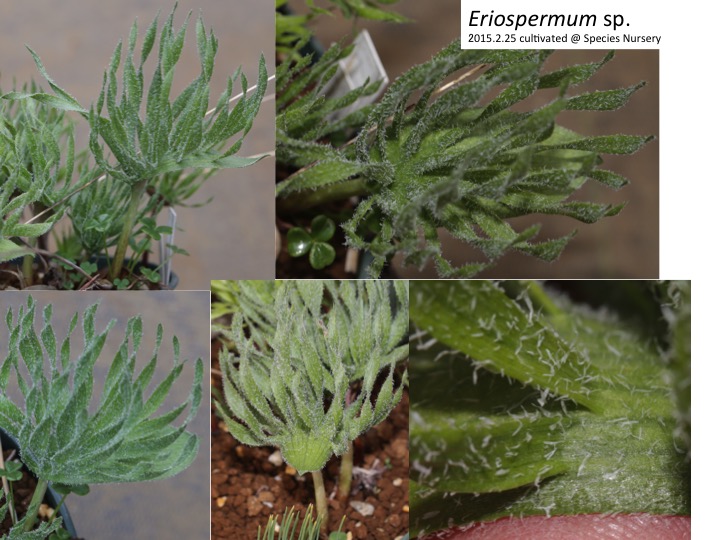
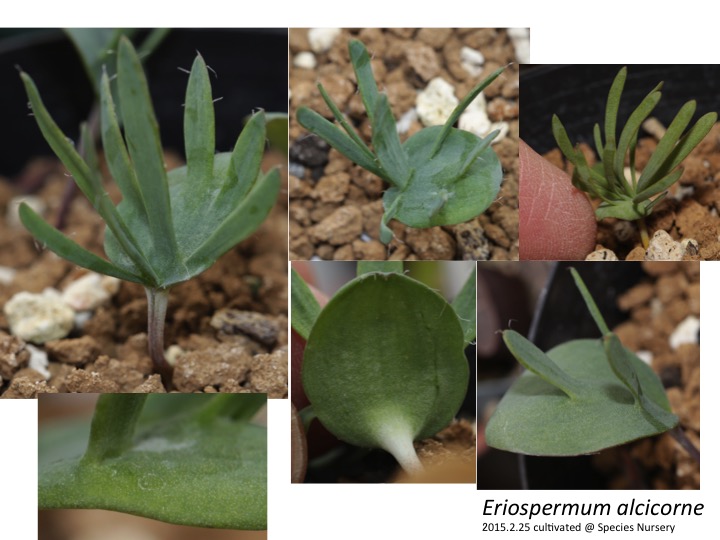
栄養花序様器官が癒合したなら、突起の出ている部分から葉の基部にわたり、維管束が本来の苞の維管束と重複しているかもしれない。
If vegetative inflorescence-like organ is fused, vascular bundles may be doubled from the junction to a leaf base.
E. appendiculatumの突起は栄養性花序様器官が癒合したものなのだろうか。突起の先端の毛が葉縁の毛と似ているので、もしかすると、他の種類の突起とは違って、葉縁で発現すべき遺伝子が異所的に発現することで葉の表面の細胞が葉縁として運命づけられたのかもしれない。
It is quite hard to say these appendages are homologous to the vegetative inflorescence-like organ. Hair at the tip of an appendage is similar to that at the leaf margin, suggesting that the appendage captures a part of fate of leaf margin with meristematic activity.

